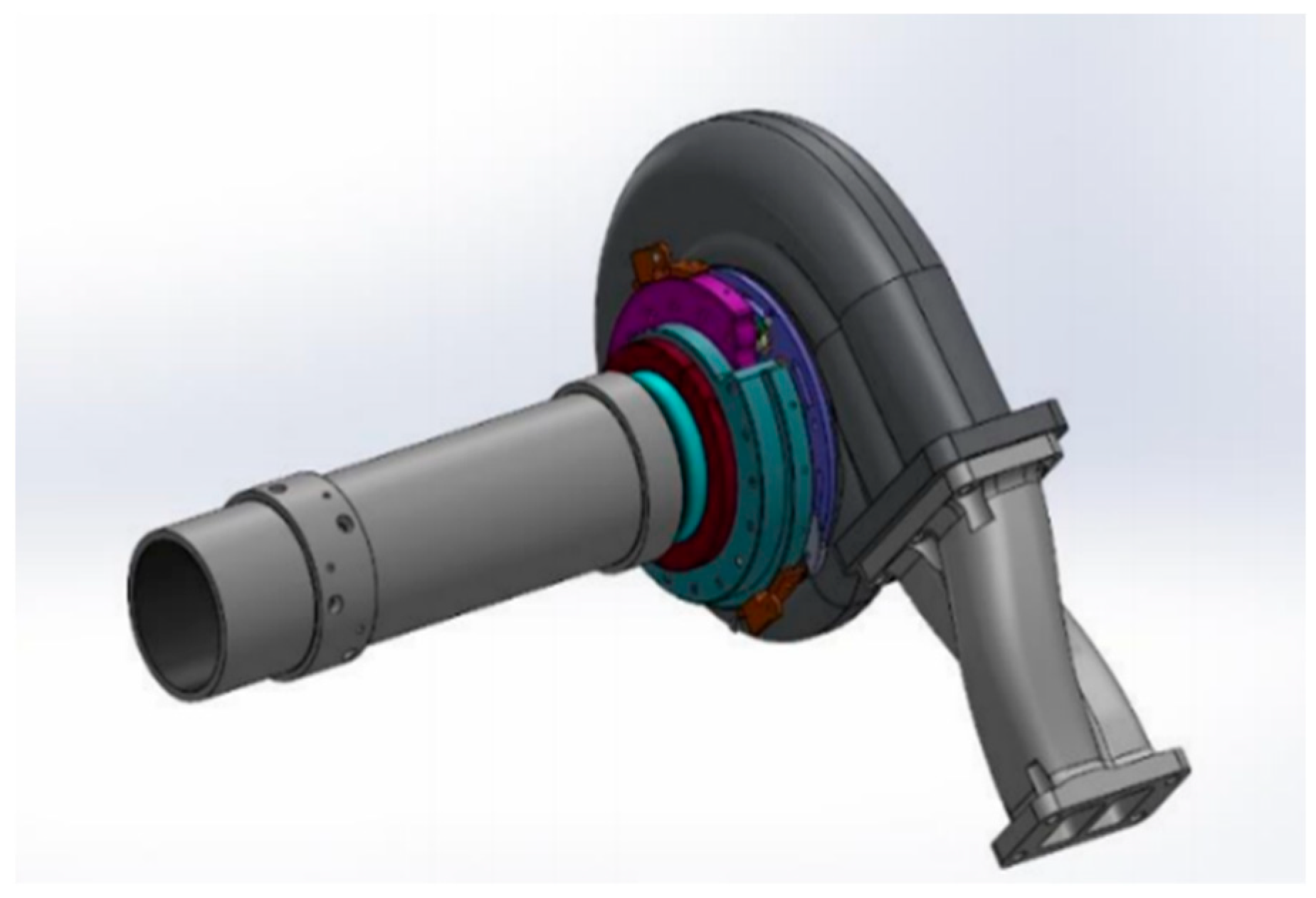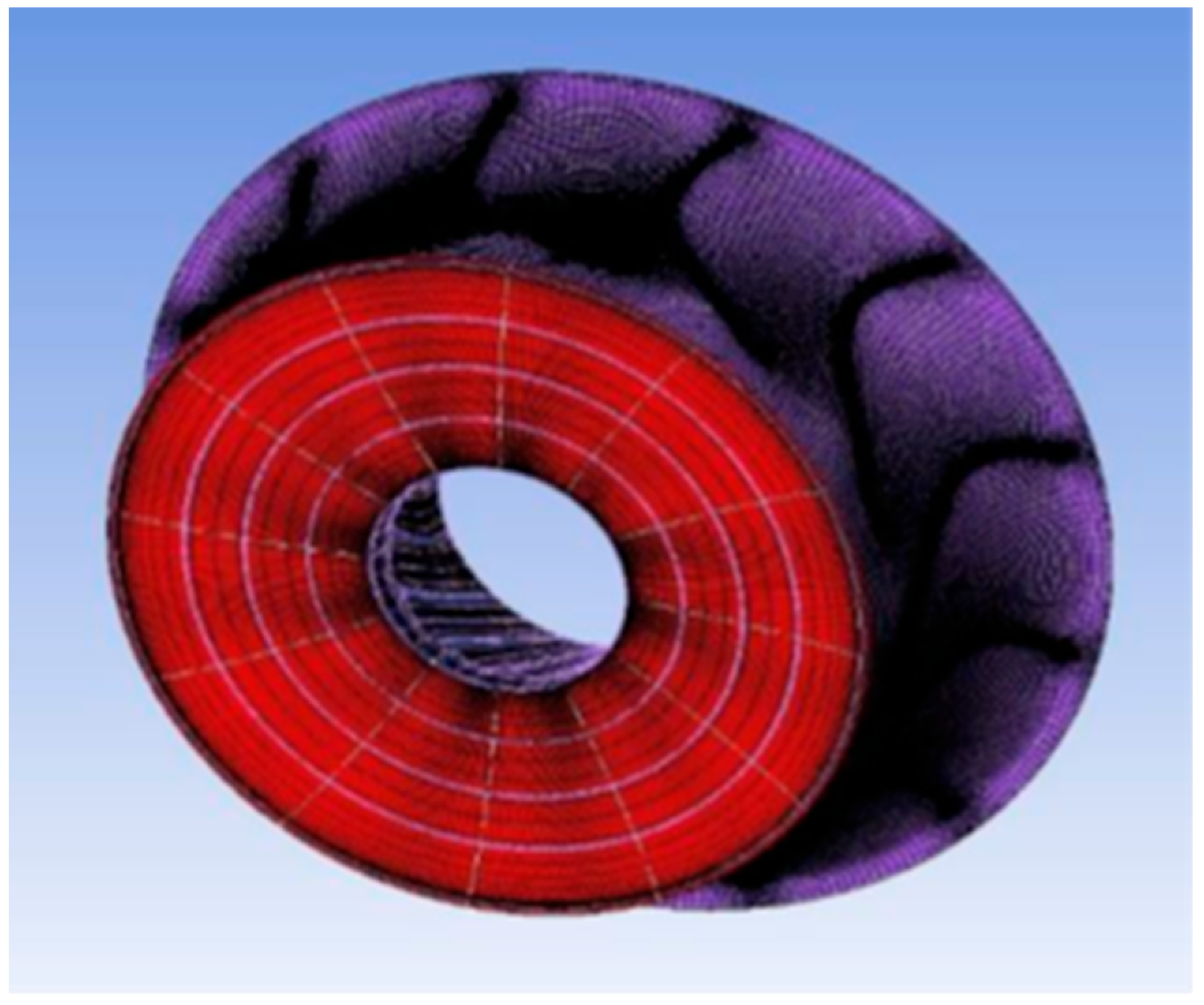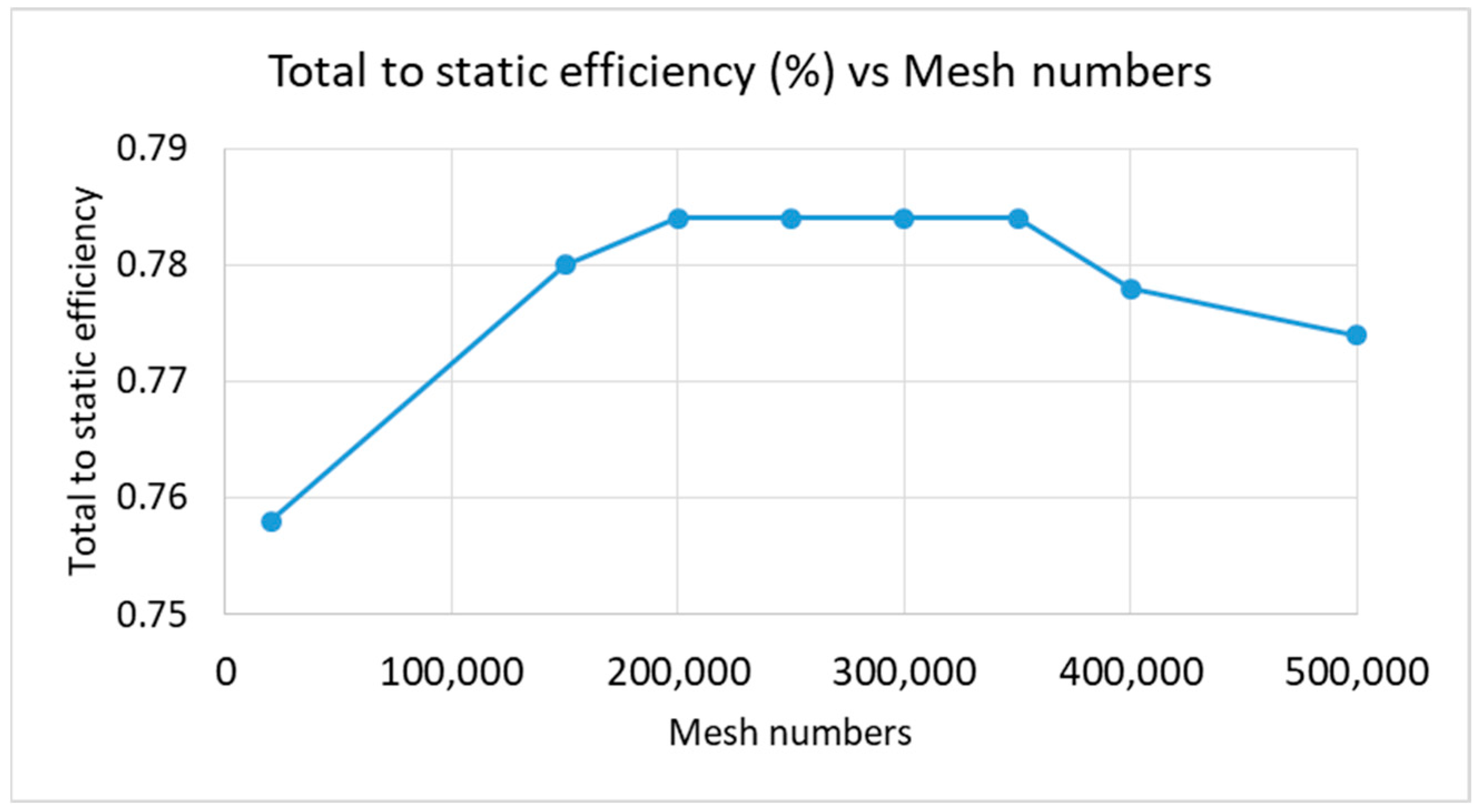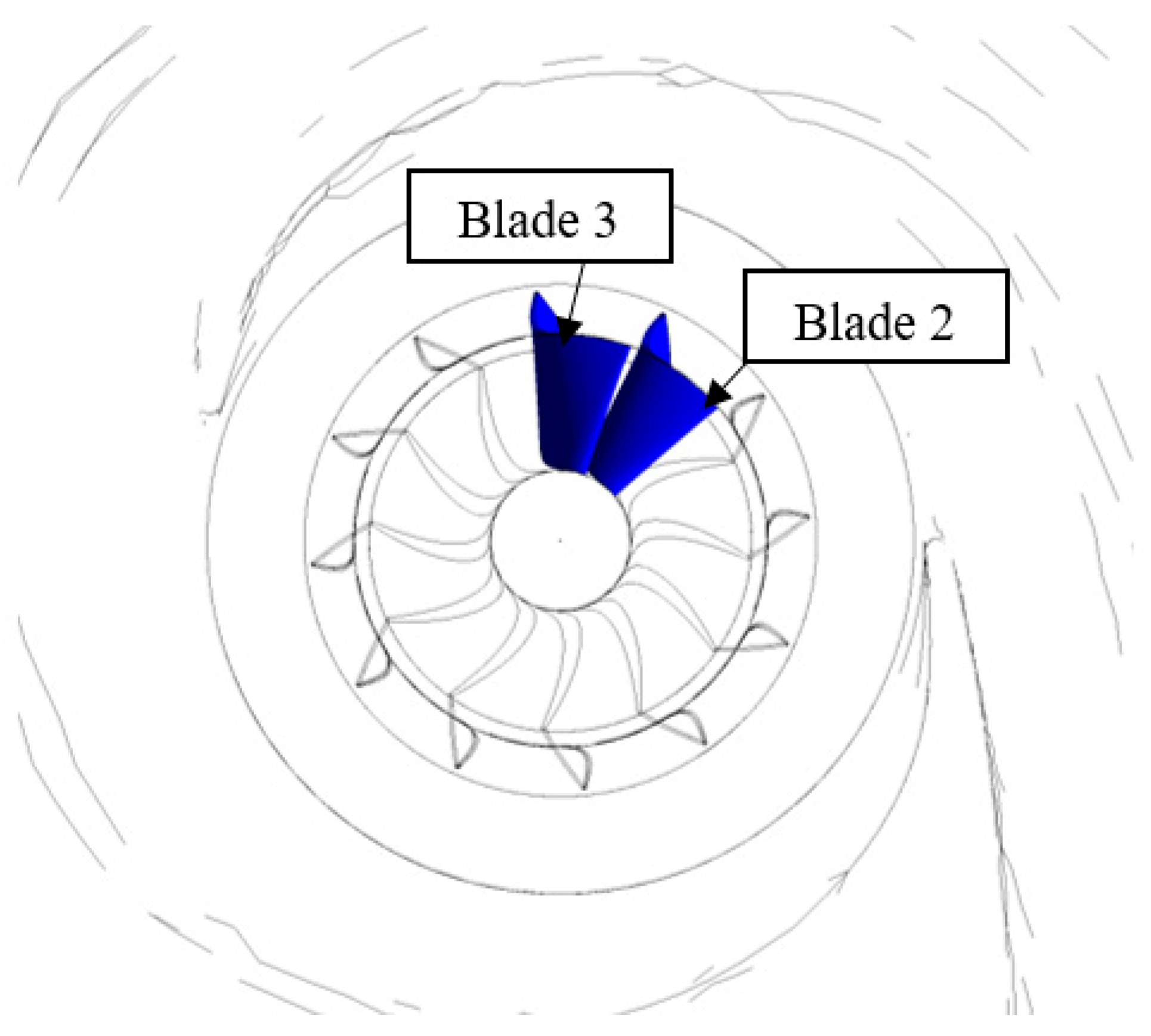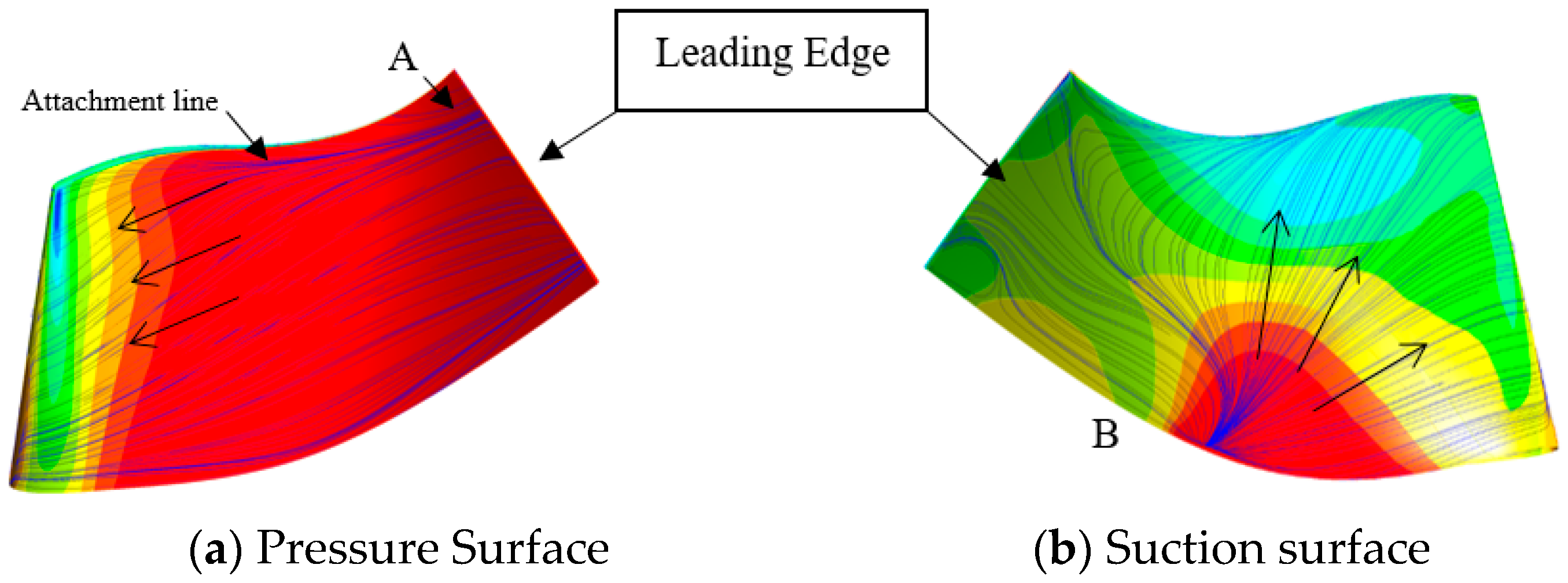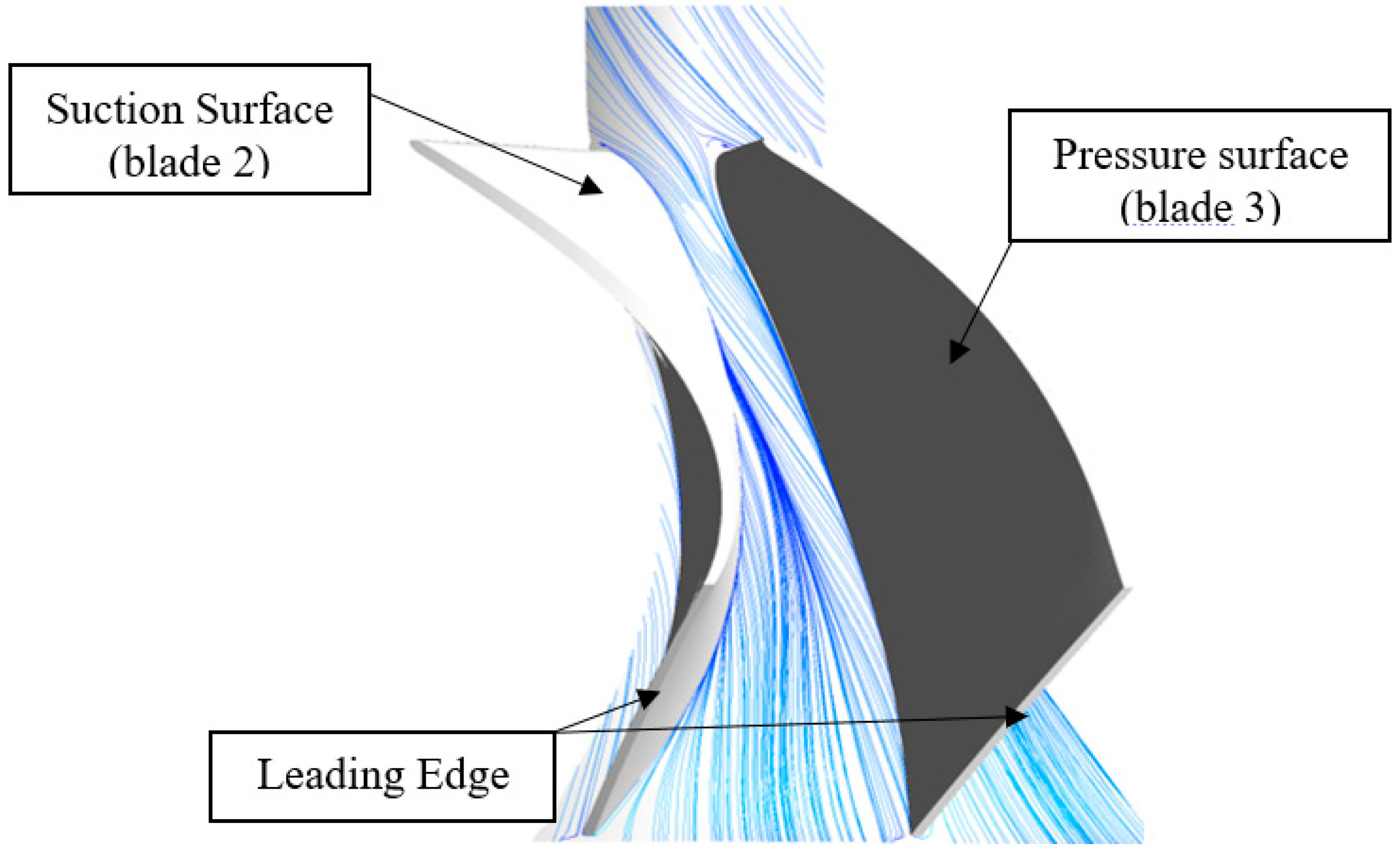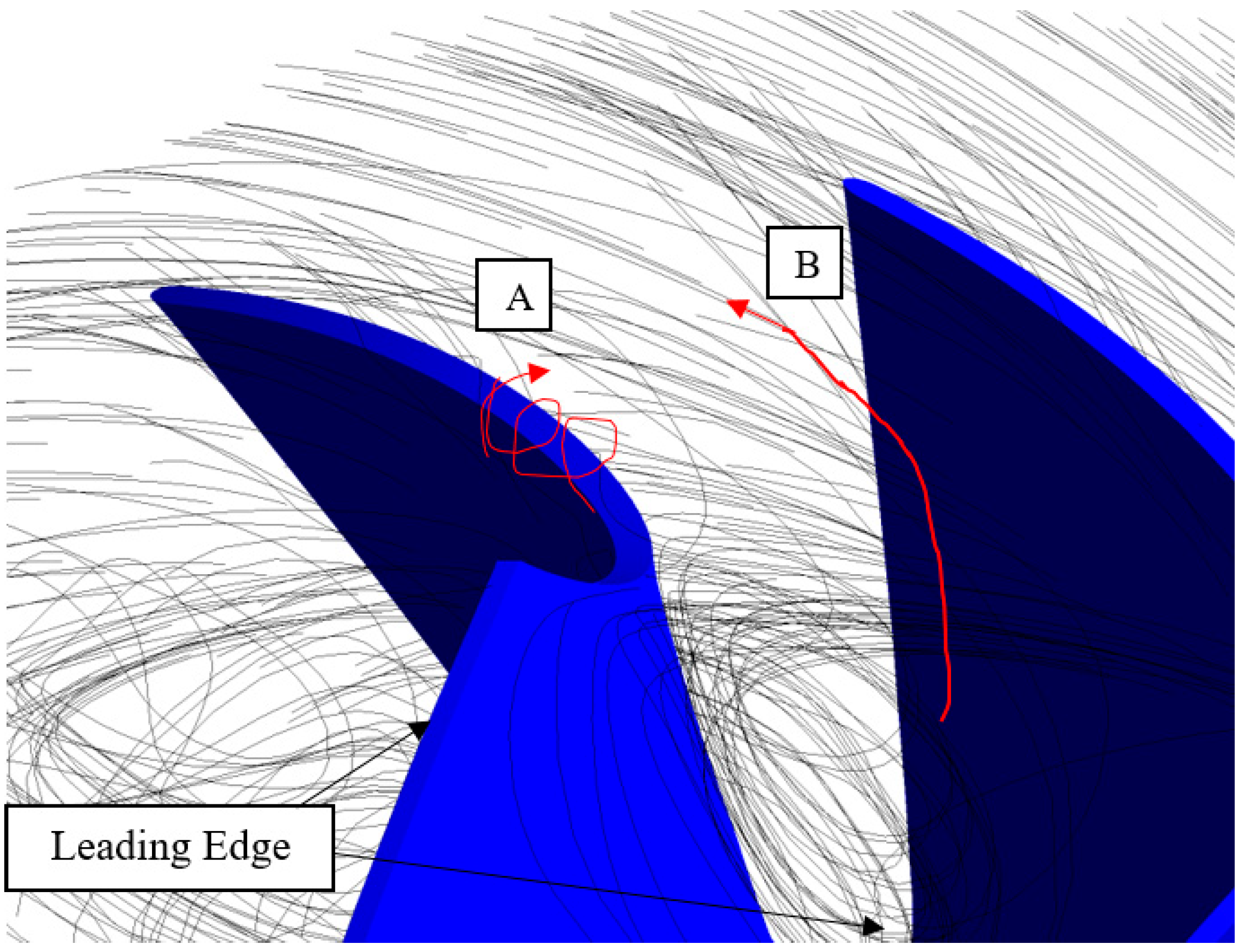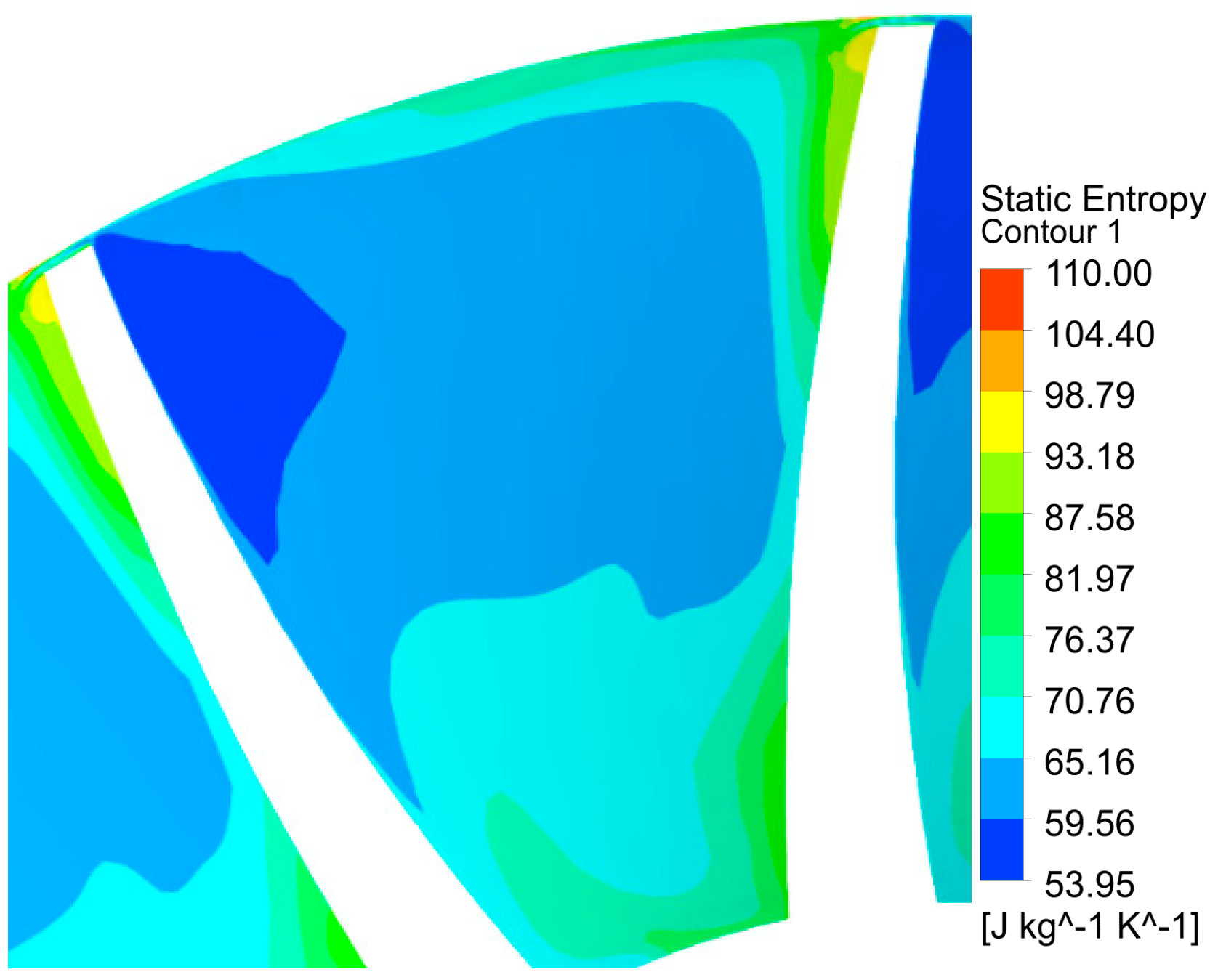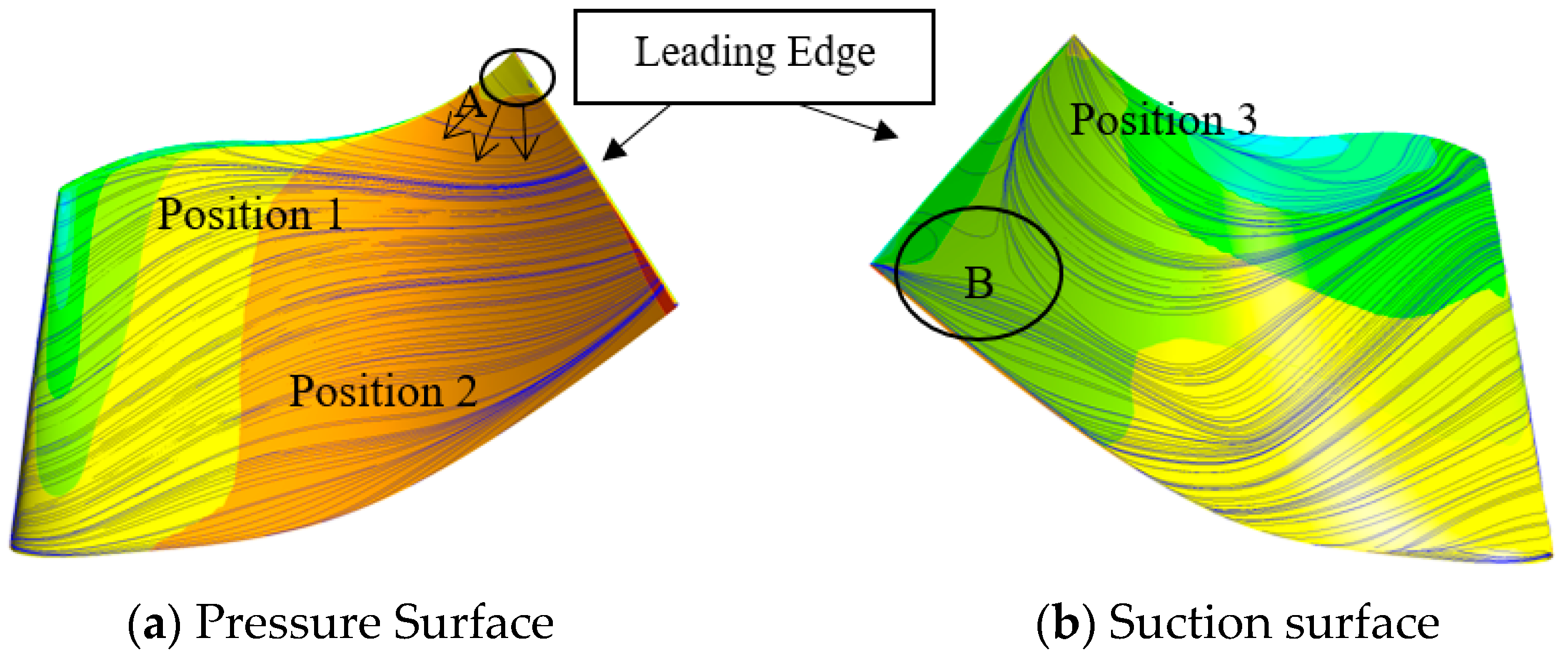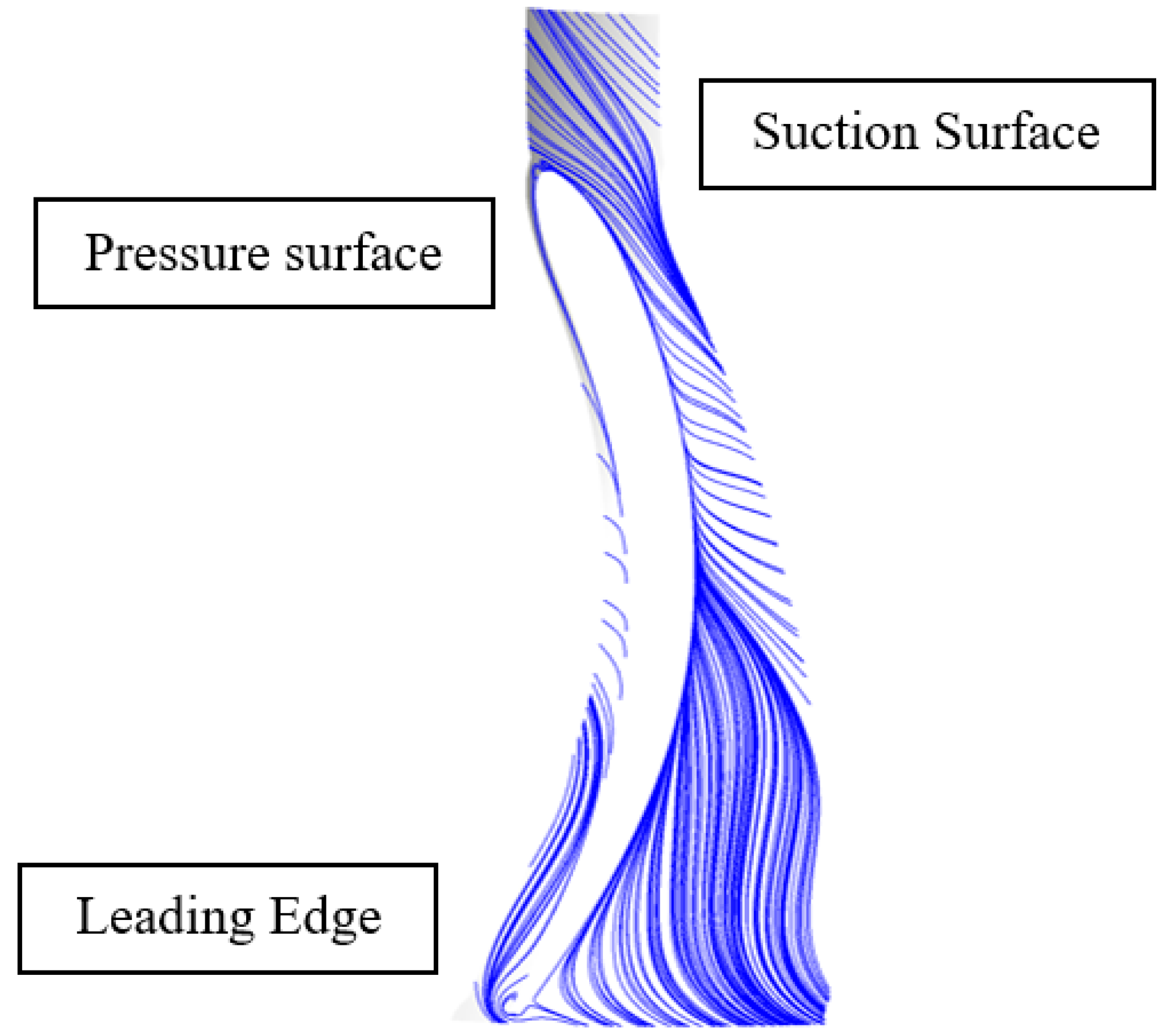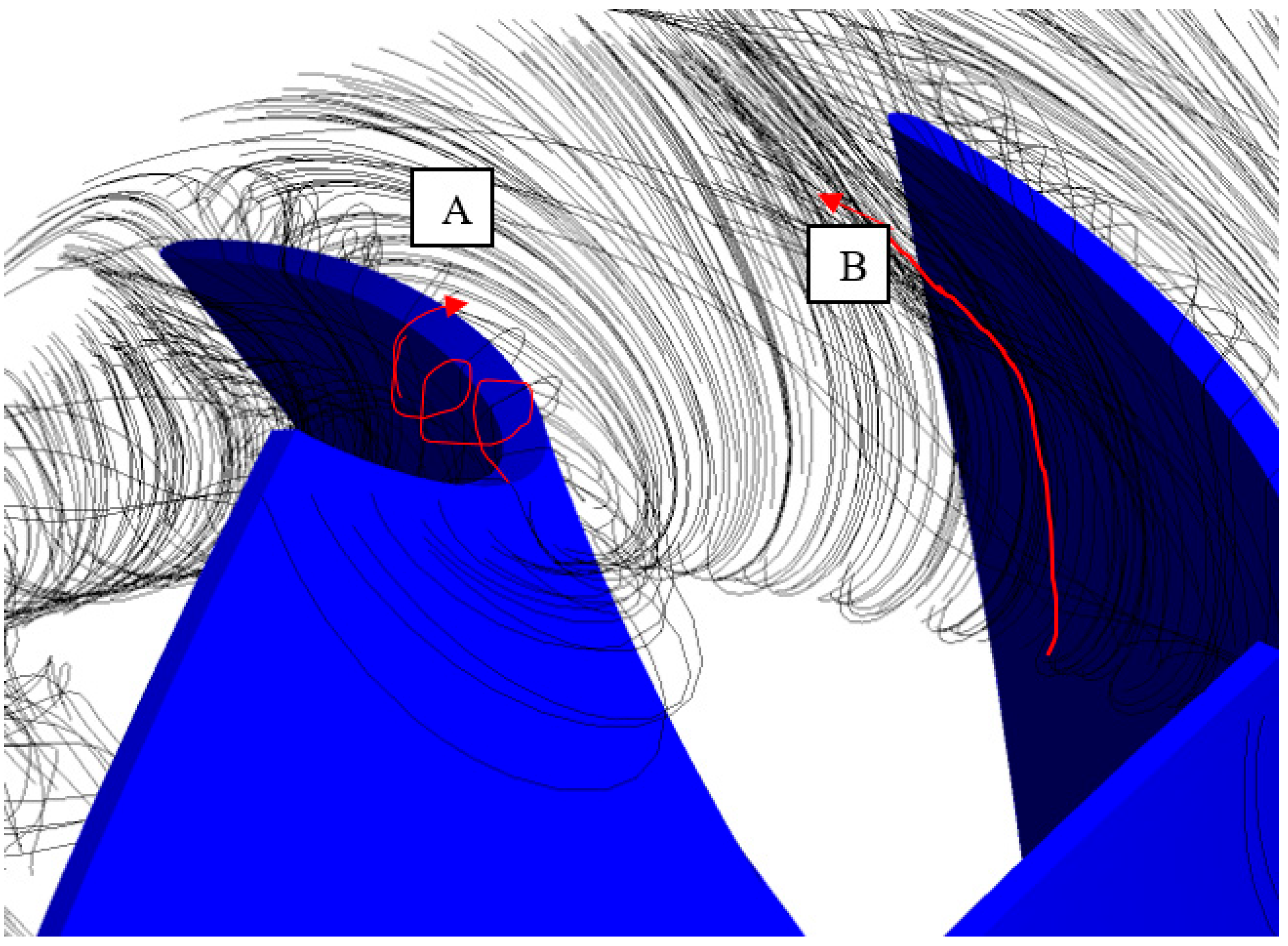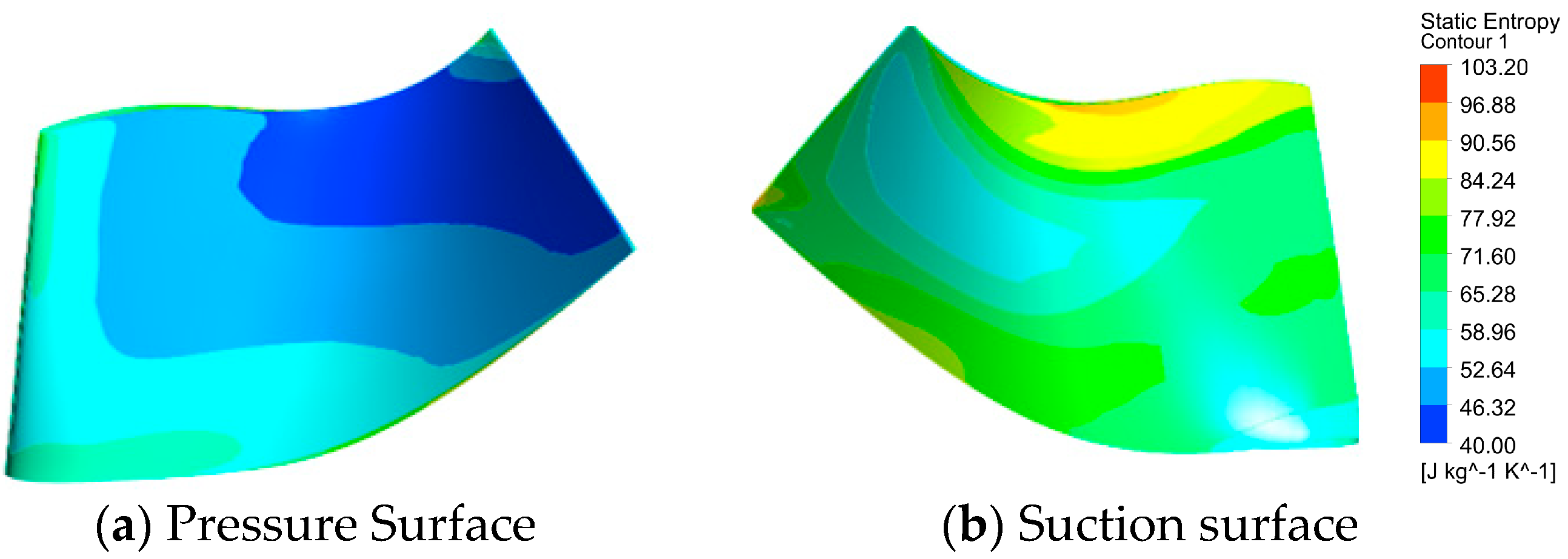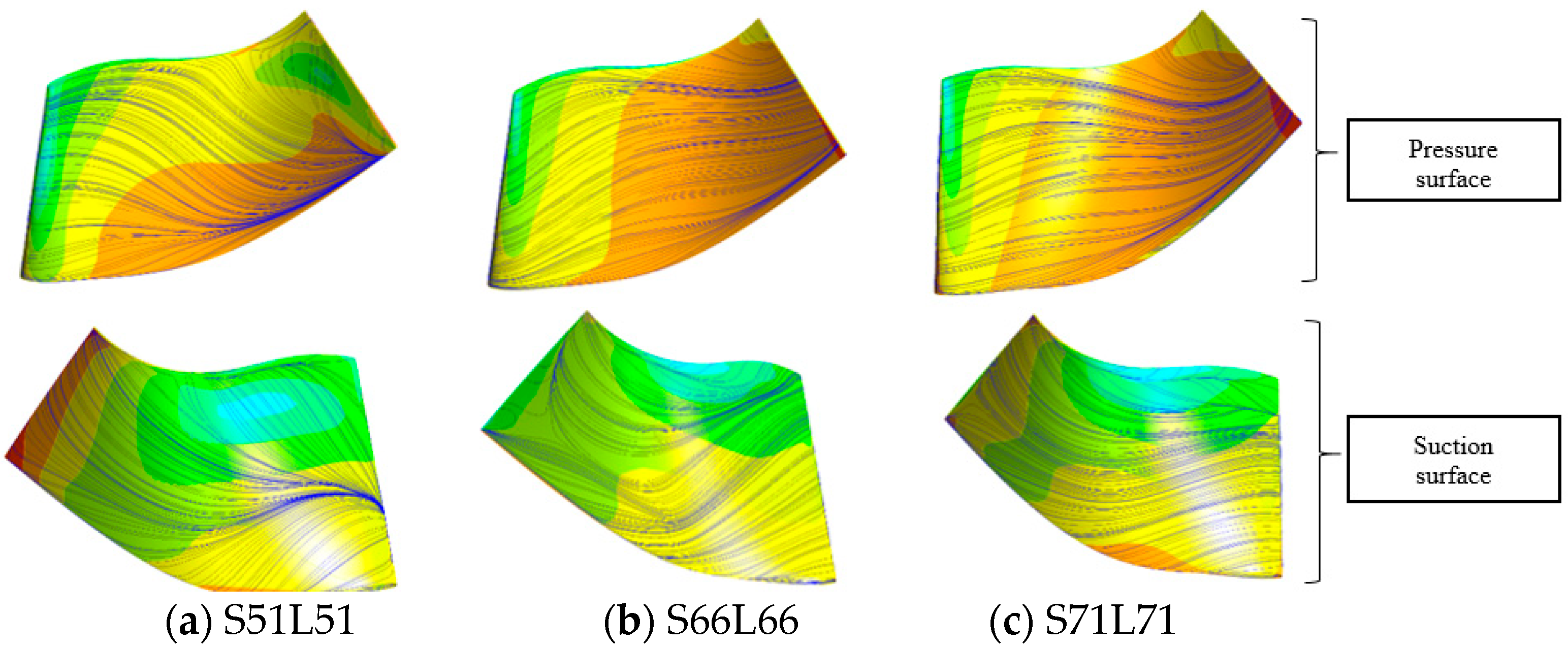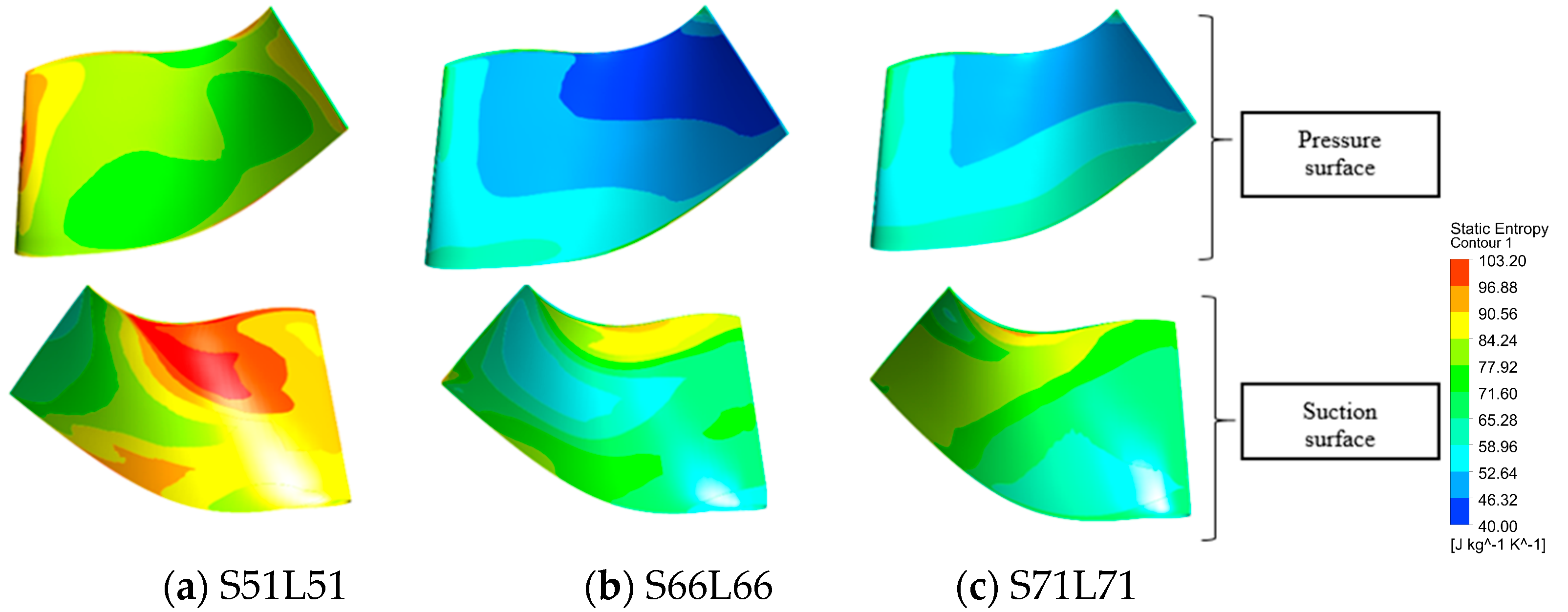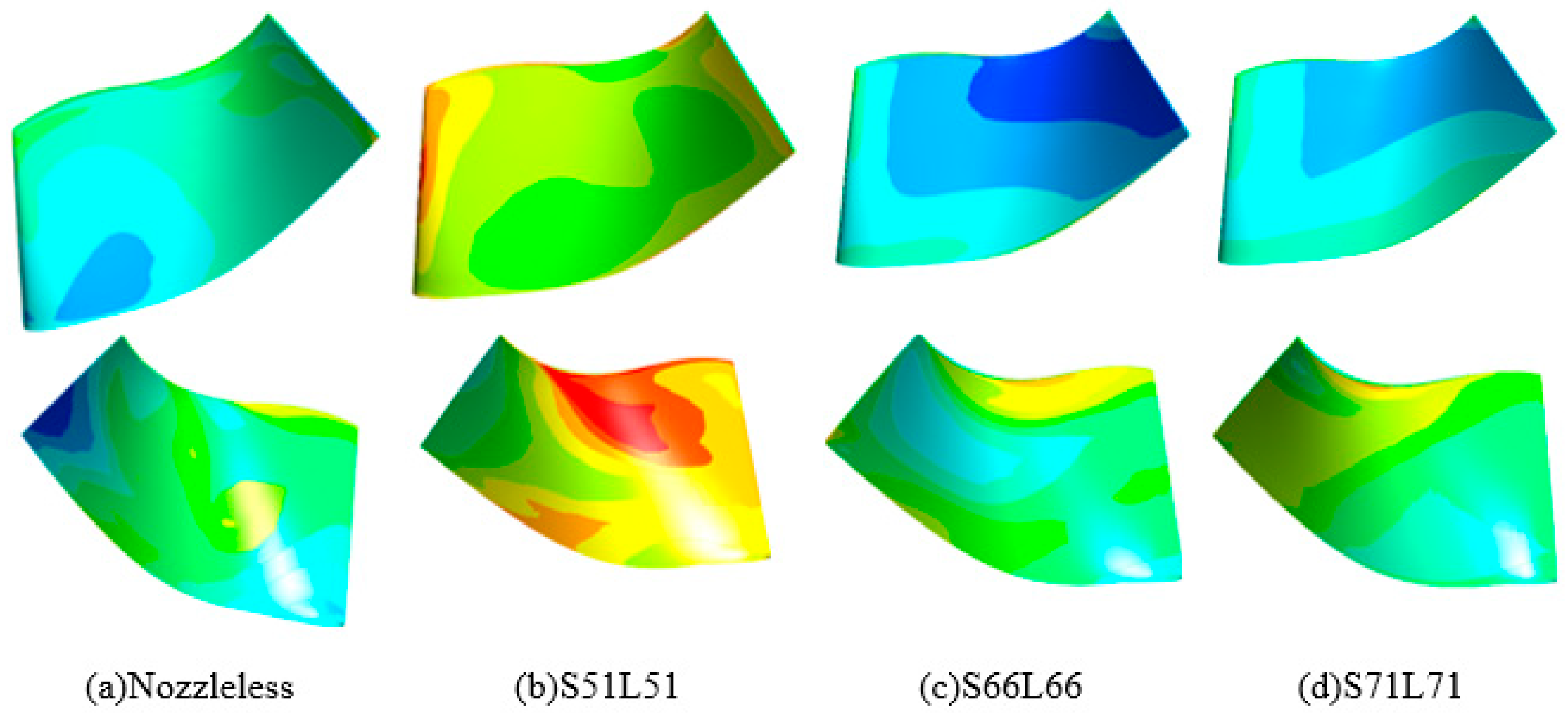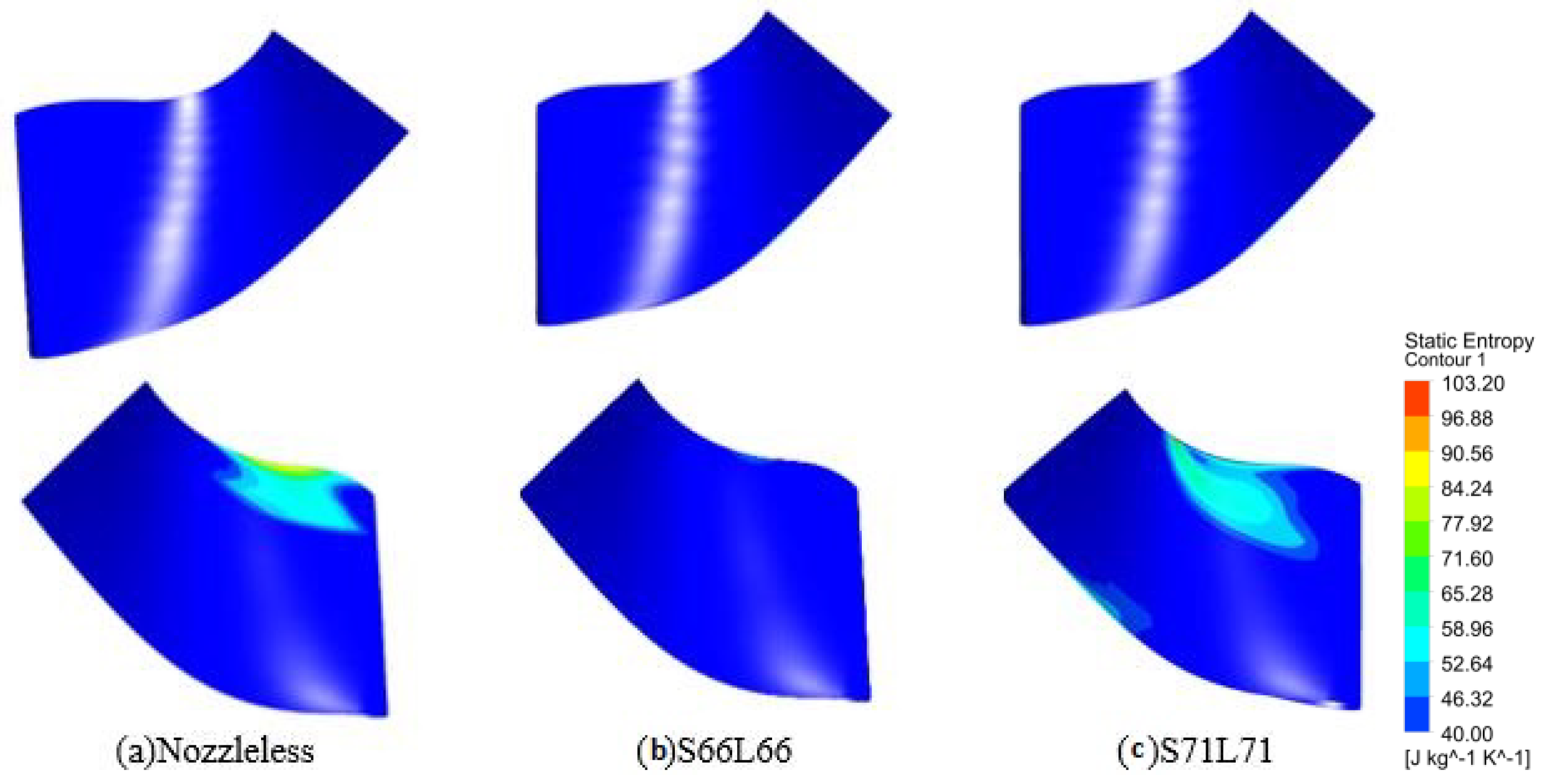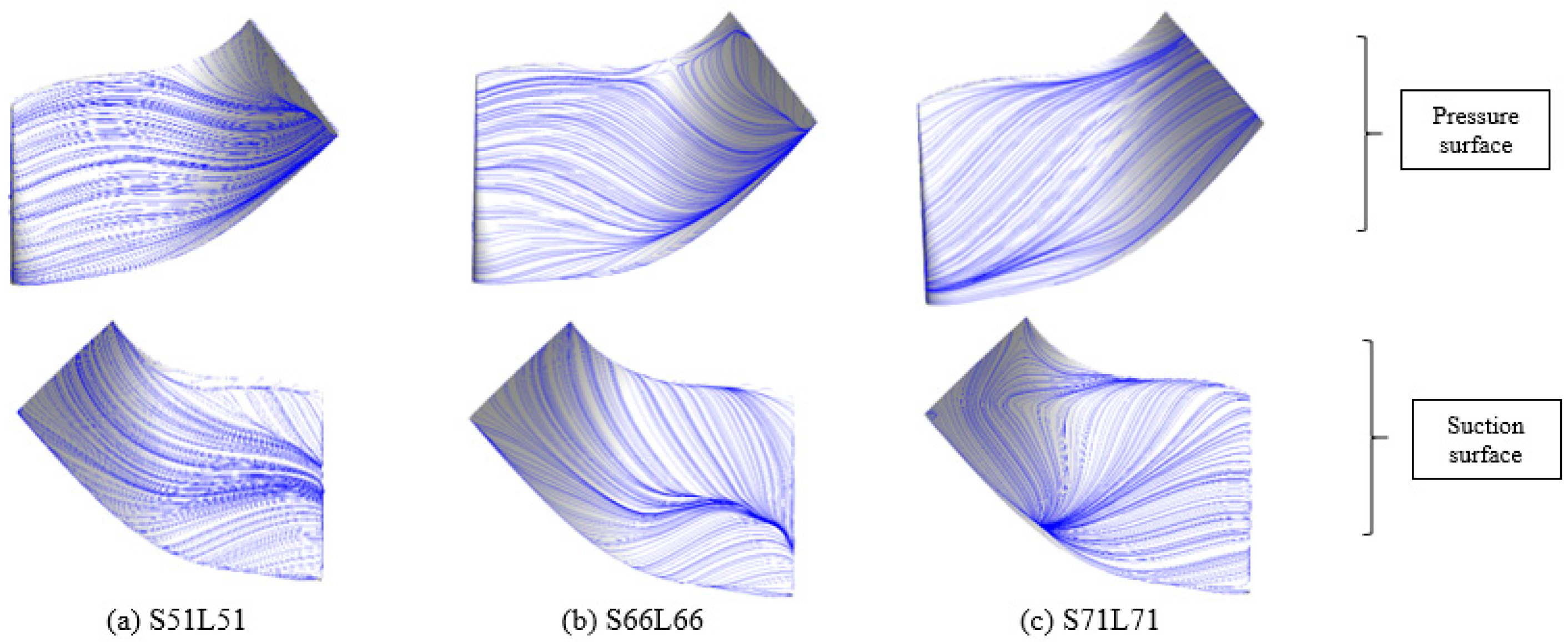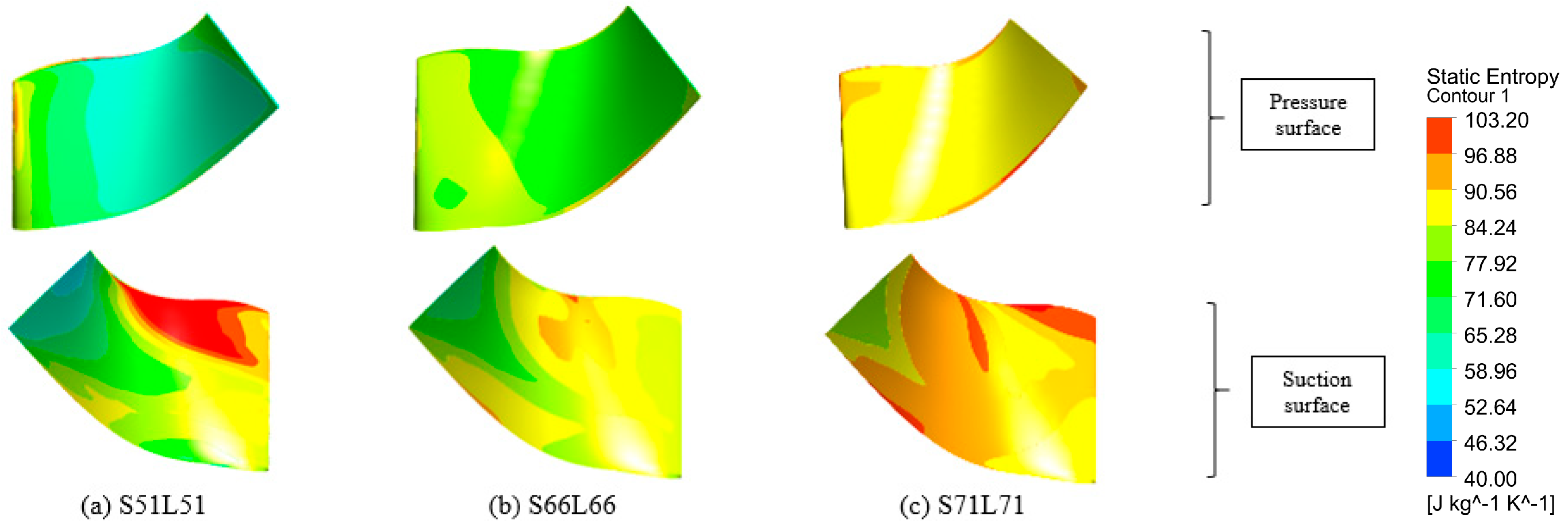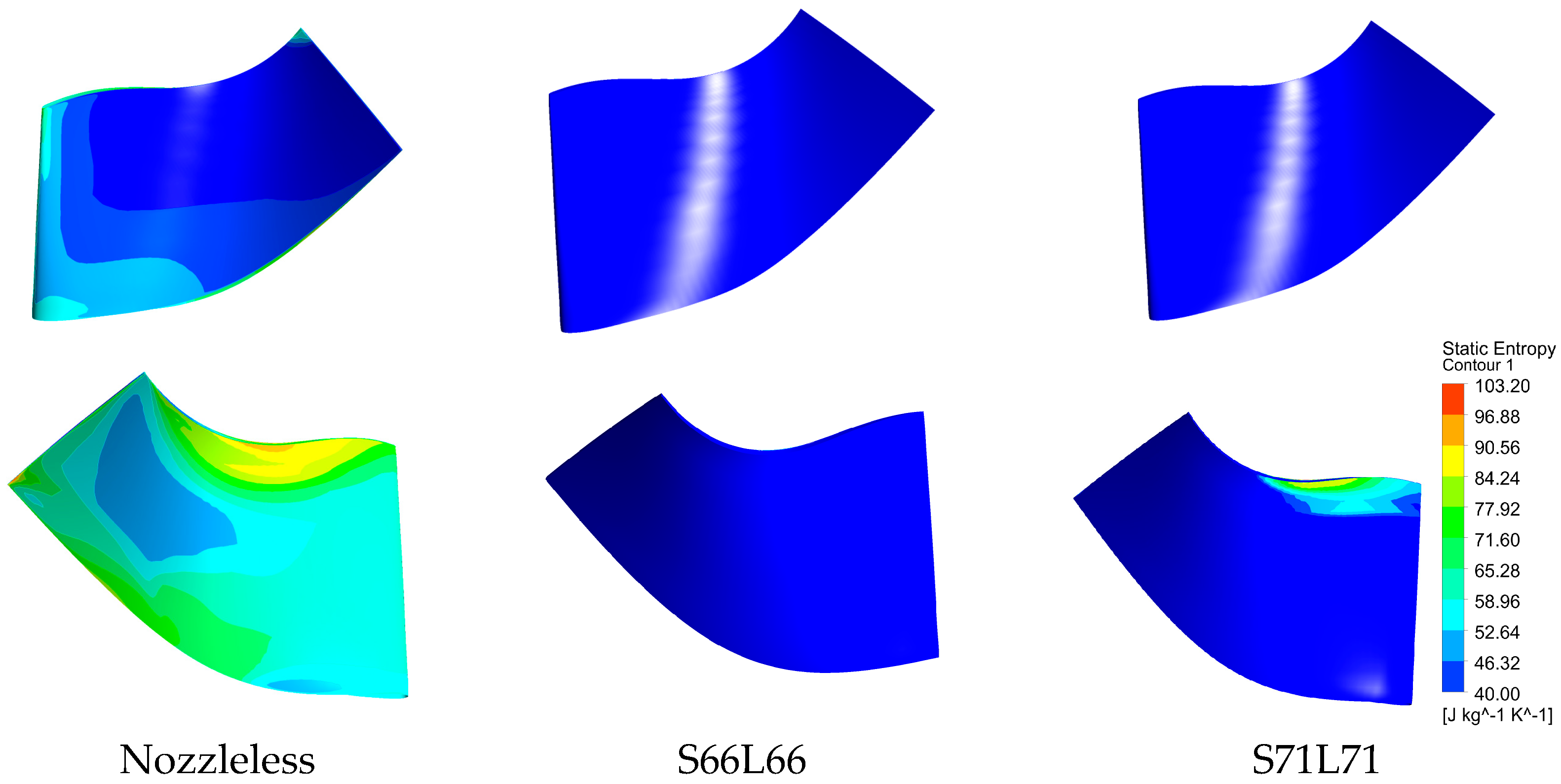3.1. Design Point
The nozzleless turbine is the chosen configuration to be the baseline among other configurations shown in
Table 5. The absence of skin friction loss in the nozzleless configuration is the primary reason for the latter being selected as the baseline model.
Figure 9 shows the fluid domains of the nozzleless and nozzled configurations.
The flow field analysis is carried out through the entire simulation using the flow entering the chosen rotor passage. The distribution of incidence angle and entropy generation are being examined to select the proper passage for analysis. In the nozzleless and symmetric (S66L66) configuration, the incidence angle at 30 K rpm is recorded at −12° and −4°, respectively.
Figure 10 shows the incidence angle distribution across the periphery of the turbine at a specific spanwise of 0.4 for both configurations. It demonstrates a uniform distribution for each rotor passage with a deviation of 1% average incidence angle for both configurations.
Figure 11 shows the entropy generation distribution in both nozzleless and symmetric configurations where it has quite the same level of fluctuation because of the uniformity of the flow entering the rotor passage blade. Thus, the continuation of the loss distribution can be investigated by using a single passage analysis for the nozzleless and symmetric configuration. The passage between blades 2 and 3 is chosen randomly for the secondary flow analysis through the entire simulation, as shown in
Figure 12.
In the nozzleless configuration, the volute is responsible for maintaining the swirl component of the flow while setting the flow angle at the rotor inlet. With the absence of a nozzle vane in a nozzleless configuration, the reduction of skin friction loss helps in guiding the flow into the rotor without any power loss.
The flow field predicted by the peak efficiency point of nozzleless configuration is studied first. The contour plot of reduced pressure on both pressure and suction surfaces with the lines of wall shear stress is presented in
Figure 13, where the significant influence of secondary flow from the reduced pressure perspective is shown. From the leading edge of the blade on the hub surface, as illustrated in
Figure 14, it is possible to see that the flow moves from the pressure surfaces towards the suction surface and trails the passage pressure gradient with no obvious trace of separation. On the pressure surface, it can be observed that the reduced pressure gradient is favorable close to the leading edge and an attachment line is formed near the shroud side and the rest of the flow is moving from the leading edge to the trailing edge smoothly. The reduced pressure gradient upstream of feature A acts to drift the friction lines formed into an attachment line to the shroud surfaces indicating significant proof of the tip leakage as reported by many researchers on the axial turbine blade. Feature A shows the focus point near the leading edge of the shroud side. However, on the suction surface, some of the critical points such as focus, saddle points, and attachment nodes are located clearly. The attachment node at the hub side of the suction surface indicates the horseshoe vortex development is taking place there. The flow is moving upwards towards the shroud side blending with the tip leakage vortex friction lines. The flow topology on the suction surface as illustrated in
Figure 13b shows a saddle point located near the leading edge of the 90% blade span representing the tip leakage flow drifted from the pressure surface. It is also noted that separations occur on the suction surface.
Figure 15 shows the flow near the shroud predicted by the number of particles released at the leading edge of the rotor passage at 90% of the blade span. The strength of the tip leakage vortex indicated by Feature A is seen in this plot, where it peaks at 50% of the blade chord. In addition, Feature B, which characterizes the shroud side passage vortex, is also clearly seen in this plot as it is possible to see the movement of fluid from the pressure surface across the passage to the suction surface.
This operating condition with the incidence angle of the flow entering the rotor passage at −12°, almost favorable degree of incidence angle, results in a fairly orderly flow field that follows the blade curvature on the pressure side of the blade, as shown in
Figure 16. As a consequence, low levels of loss in the pressure surface are seen when compared to that associated with the suction surface. The tip leakage vortex which is fed by the flow moving up in a positive spanwise at the leading edge is demonstrated in
Figure 17, which shows a cross-section passage at 50% of the blade chord. In
Figure 16b, there is a region where high entropy generation is detected at the shroud side where the development of tip leakage vortex occurs. Some of the flow leaks over the blade tip from the pressure side to the suction side; this creates a strong tip leakage vortex on the pressure side of the tip section. This tip leakage vortex stretches the entire length of the blade chord and the remainder of the flow moves down to the hub side of the suction surface. This flow also creates another area of entropy generation in the hub region of the suction surface known as the horseshoe vortex, but this is not as strong as the tip leakage vortex.
The maximum pressure difference between the shroud and hub side is used in this simulation to indicate the strength of the centrifugal pressure head at the rotor inlet. Nozzleless configuration records a maximum pressure difference of 1.048 kPa.
As the symmetric nozzle vane is introduced, the role of the volute in determining the flow angle entering the rotor inlet has been transferred to nozzle vanes. S66L66 configuration will be used to analyze the flow field and secondary flow owing to its highest peak efficiency amongst all symmetric configurations. The flow topology at both the pressure and suction surfaces of the blade for S66L66 is presented in
Figure 18. Theoretically, the S66L66 has a small negative incidence angle of −4°, which tends to create the flow separation which is more significant at the pressure surface compared to the suction surface. This is verified by a critical point and two attachment lines located at the pressure surface, as shown in
Figure 18a. In addition, the occurrence of critical point and attachment lines is more significant in the nozzled configuration than the nozzleless configuration. The concentration of attachment lines (Position 1) near the shroud side is stronger than the nozzleless configuration, which is caused by the critical point (Feature A) at the tip of the leading edge. The attachment lines also terminate near 80% streamwise, similar to nozzleless configurations. Hence, the attachment lines (Position 2) near the hub side suggest that the flow has a separation due to the weak horseshoe vortex which can be seen up through 50% streamwise. For the flow field at the suction surface, the concentration of flow separation is weaker than that of the nozzleless configuration. A saddle point (Feature B) located at 20% blade span near the leading edge produces attachment lines near the shroud side (Position 3). Concisely, the flow in symmetric configuration tends to separate at both blade surfaces and is more significant at the pressure surface as opposed to the nozzleless configuration where the flow separation is more significant at the suction surface.
The flow on the hub surface has the same pattern with a nozzleless configuration as in a symmetric configuration, as shown in
Figure 19, where the flow moves from the pressure surfaces to the suction surfaces, but with a high concentration of flow from the leading edge to 50% of the blade chord. Furthermore, no distinct flow separation is seen there.
At 90% blade span, the development of the tip leakage vortex is stronger with a higher concentration of recirculating flow (Feature A) than the nozzleless configuration. In addition, the inflow vortex (Feature B) shows a stronger concentration located near the suction surface. The strong recirculation flow is induced by the attachment lines located at both the shroud side of the pressure and suction surfaces, as shown in
Figure 20.
The flow topology at S66L66 has clearly shown the existence of tip leakage vortex and horseshoe vortex development. The entropy generation, as shown in
Figure 21, verifies the occurrence, with a bigger area of high entropy spotted at the suction surface where it is more significant than the nozzleless configuration. The development of a tip leakage vortex and cross passage at the suction surface become stronger caused by the critical points where the flow separation becomes more significant after 50% of the blade chord at the suction surface. The tip leakage vortex, which is fed by the flow moving up in a positive spanwise at the leading edge, and the cross-passage vortex are demonstrated in
Figure 22, which shows a cross-section passage of entropy generation at 60% of the blade chord where it seems the higher entropy located only at the suction surface. In addition, the horseshoe vortex induced by Feature B in
Figure 18 has created some regions with high entropy near the hub side of the suction surface, which is more significant than the nozzleless configuration.
The presence of a symmetric nozzle vane in the nozzle interspace has affected the maximum pressure difference between the hub and shroud. The secondary flow development in symmetric configuration changes the magnitude of pressure difference to 1.5 kPa, which is 50% more than the nozzleless configuration.
The symmetric opening vane angle has been an important factor that influences the overall turbine efficiency where the total to static efficiency difference between nozzleless and nozzleless turbines is significant. S71L71 has the smallest opening vane angle compared to S66L66 and S51L51. The difference in flow topology as the nozzle vane closes in symmetric configurations is shown in
Figure 23. As the nozzle vane opens from S71L71 to S66L66, the attachment lines shift towards both the shroud and hub side at the pressure surface and the focus point at the tip of the leading edge becomes more significant and the attachment lines at the shroud side of the suction surface have a bigger area coverage due to the strong tip leakage vortex. Moreover, as the nozzle vane opens from S66L66 to S51L51, the concentration of attachment lines at the pressure surface becomes significant with a bigger focus point and the attachment lines at suction surfaces have stretched through the trailing edge.
Entropy generation is the best parameter to consider in evaluating losses due to the flow separation as the opening vane angle increases. This is shown in
Figure 24. As the nozzle vane opens from S71L71 to S66L66, the magnitude of entropy generation at the shroud side of the suction surface decreases and it spreads across the surface. However, as the nozzle vane opens from S66L66 to S51L51, the area of high entropy generation at the shroud side is more significant with a larger area of high intensity across the surface.
In addition, from the centrifugal pressure head perspective, the maximum pressure difference has a changing trend as the nozzle vane closes as shown in
Table 6. As the nozzle vane opens from S71L71 to S66L66, the centrifugal pressure head has a decreasing trend, as opposed to the nozzle vane opening from S66L66 to S51L51. This is due to S66L66 having the weakest flow separation that indicates the lowest losses, resulting in the lowest centrifugal pressure head while S51L51 has the strongest flow separation with a higher number of attachment lines and critical points. On the other hand, S71L71 has a mild flow separation, which is stronger than S66L66, but weaker than S51L51.
The concentration of flow separation at pressure and suction surfaces increases as the opening vane angle increases. Furthermore, as the nozzle vane opens, the magnitude of entropy generation increases and is located at the shroud side only.
As the turbine rotational speeds increase from 30 K rpm to 48 K rpm, the flow topology for all configurations changes. As in nozzleless configuration, the flow tends to separate at both sides of the suction and pressure surface. On the pressure surface, it can be observed that the reduced pressure at the leading edge does not have a smooth gradient compared to 30 K rpm because the strength of the centrifugal pressure head is stronger as rotor speed increases. In addition, an adversely reduced pressure gradient can be seen near the attachment lines. At the hub side, the reduced pressure gradient acts to drift the friction lines upwards to form an attachment line at the shroud surfaces showing significant proof of the horseshoe vortex, known as the hub-side passage vortex. On the other side of the suction surface, two separation lines are located near the trailing edge of the 40% blade span where the development of the horseshoe vortex is weaker as turbine speeds increase. In summary, the flow still separates at both surfaces but with the least critical points and fewer attachment lines as the turbine speeds increase.
With the presence of symmetric nozzle vanes of 66° (S66L66 configuration), the flow only separates at the pressure surface of the blade as the turbine speeds increase. The attachment lines on the pressure surface are still noticeable but with a weaker concentration. There is only one focus point located at the leading edge of the shroud side as the turbine speeds increase.
Generally, the flow in the nozzleless configuration has the least separation compared to the nozzled configurations as the turbine speed increases.
Figure 25 and
Figure 26 show the difference in flow topology between nozzleless and all symmetric nozzle configurations at both turbine speeds of 30 K rpm and 48 K rpm, respectively. At 30 K rpm, as the symmetric nozzle vane is introduced, the flow topology becomes slightly different at both surfaces compared to the nozzleless configuration, in which at least three attachment lines and two critical points are observed. On the other hand, when the nozzle vanes are introduced into the nozzle interspace at 48 K rpm, the flow tends to separate at the pressure surface only as opposed to the nozzleless configuration where it separates at both sides of pressure and suction surfaces. In addition, the concentration of flow separation at 48 K rpm is weaker than 30 K rpm with a maximum of two attachment lines and a single focus point noticed.
From the symmetricity perspective, as the nozzle vane opens from S71L71 to S66L66 at 48 K rpm, the attachment lines at the pressure surface are thinner than 30 K rpm at suction surfaces, and the attachment line diminishes, while the focus point near the leading edge of the pressure surface is still observed at both 30 K rpm and 48 K rpm. In conclusion, the influence of symmetricity on the flow separation is the same but with lower intensity as the turbine speed increases.
From the entropy generation perspective, a distinct difference is observed as the turbine speed increases where the magnitude of entropy generation at both pressure and suction surface changes.
Figure 27 and
Figure 28 show the difference in entropy generation between nozzleless and all symmetric configurations for turbine speeds of 30 K rpm and 48 K rpm, respectively.
In the nozzleless configuration, the magnitude of entropy generation at both pressure and suction surface is reduced significantly as the turbine speed increases from 30 K rpm to 48 K rpm. In addition, the region of high entropy generation is only located at the shroud side of the suction surface. Meanwhile, with the presence of a symmetric vane angle of 66° (S66L66), low entropy generation at both scrolls is spotted as turbine speed increases. However, the region of high entropy generation at the suction surface is much smaller than the nozzleless configuration as turbine speed increases.
As the nozzle vanes are introduced into the turbine at 30 K rpm, the entropy generation significantly increases at both surfaces and becomes more pronounced near the shroud side of the suction surface. However, as turbine speed increases to 48 K rpm, the region and magnitude of entropy generation are smaller, especially at the suction surface.
From the symmetricity perspective, as the nozzle vane closes from S66L66 to S71L71 at 30 K rpm, the region of entropy generation at the shroud side of the suction surface grows bigger while a small deviation happens at the pressure surface. As the turbine speed increases to 48 K rpm, the same pattern of entropy generation occurs but with low intensity where there is only one spike of entropy generation spotted at the shroud side of the suction surface. In summary, S66L66 has the smallest region of high entropy indicating the least losses at both turbine speeds among other symmetric configurations.
Table 7 shows the maximum pressure difference between the hub and shroud for both nozzleless and symmetric configurations. The maximum pressure difference indicates the increasing trend of the centrifugal pressure head for all configurations at both turbine speeds of 30 K rpm and 48 K rpm. At both turbine rotational speeds of 30 K rpm and 48 K rpm, the nozzleless configuration has the lowest maximum pressure difference among all configurations. With the presence of nozzle vanes in the turbine, the centrifugal pressure head increases at both turbine speeds where 48 K rpm has a smaller deviation, of 10%, than 30 K rpm. From the perspective of symmetricity, as the nozzle vane opens from S71L71 to S66L66, the centrifugal pressure head decreases at both turbine speeds of 30 K rpm and 48 K rpm with a deviation of 13% and 11%, respectively. This shows that the influence of opening vane angles on the centrifugal pressure head also has a decreasing trend as the turbine speed increases. In conclusion, the centrifugal pressure head influence does not contribute significantly to secondary flow development as the turbine speed increases, as opposed to the incidence angle effect. However, the symmetricity has a significant impact on the centrifugal pressure head where the centrifugal pressure head increases as the nozzle vane closes from 66° to 71° at both turbine speeds. Meanwhile, as the symmetric nozzle vane closes from 51° to 66°, the symmetricity influence on the centrifugal pressure head is substantial where it decreases at 30 K rpm.
3.2. Off-Design
The off-design performance and understanding of secondary flow structures are exceptionally crucial factors in the design of automobile turbocharger turbines. The rotor encounters significant positive incidence values during off-design operation and engine transients when the turbine is running at low U/C values in the range of 0.3 to 0.5. As a result, the inlet flow is mismatched with the blading, leading to high blade loading, tip leakage, and suction surface separation. These secondary flow structures spread along the blade passage, increasing entropy and resulting in decreased efficiency.
In nozzleless configuration, the peak and minimum efficiency points are recorded at a velocity ratio of 0.6 and 0.4, respectively. As the velocity ratio decreases, a high positive incidence angle occurs where the flow separation tends to dominate at the suction surface.
Figure 29 shows the flow topology at a lower velocity ratio for nozzleless configuration. The flow topology at a lower pressure ratio of 0.44 is quite different from the peak efficiency point (PR = 0.78), as illustrated in
Figure 13. The flow at the pressure surface has more significant attachment lines with a bigger core of critical points located near the shroud side of the leading edge. The attachment lines start from 0.5 spanwise of the leading edge and extend onto 0.9 spanwise of the trailing edge. The concentration of attachment lines near the shroud is higher than the peak efficiency point. The attachment lines at the hub side also have a high concentration showing a stronger horseshoe vortex. The focus point near the leading edge is more noticeable with a bigger region. It shows significant proof of a stronger tip leakage vortex than the design point. On the other hand, the flow topology at the suction surface has a completely different flow separation, especially at the leading edge. A significant nodal point is observed at 0.4 spanwise of the leading edge. This happens due to high positive incidence which creates two different locations of attachment lines. One is located near the shroud side that is associated with the tip leakage vortex and the other one is located at the zone near the hub side, which indicates the horseshoe vortex. The concentration of attachment lines is stronger at the hub side than the shroud side. To sum up, the flow separations at both surfaces become stronger with a high concentration of attachment lines and critical points particularly at the suction surface as opposed to the design point.
Theoretically, as the flow topology changes with different flow separations, the entropy generation changes too. The off-design point has a lower efficiency than the peak efficiency point which portrayed higher overall turbine losses.
Figure 30 shows the entropy generation at the off-design point for nozzleless configuration. The magnitude of entropy generation at both surfaces increases significantly at the off-design point. On the pressure surface, the entropy generation becomes higher as the flow moves from the leading edge to the trailing edge where the highest entropy generation is spotted at the trailing edge near the hub side. For the suction surface, two regions of high entropy generation are noticeable near the shroud and hub region. The entropy generation at the hub and shroud side indicates the horseshoe vortex and tip leakage vortex, respectively. The maximum pressure difference between the hub and shroud at an off-design point is 2542 Pa.
With the presence of a symmetric nozzle vane of 66° (S66L66), the peak and minimum efficiency points are recorded at velocity ratio of 0.673 and 0.397, respectively.
Figure 31 shows the flow topology of S66L66 at the off-design point. The flow topology for the lower pressure ratio is quite different to the peak efficiency point, especially with the presence of nozzle vanes. The concentration of flow separation at the pressure surface is more pronounced than the suction surface. At the pressure surface, there are distinct attachment lines near the hub and shroud sides. The former attachment lines dominate early streamwise while the latter from the leading to the trailing edge. The attachment line at the shroud side is spread along the blade due to a nodal point spot midstream-wise of 0.9 span. The attachment lines at the hub side, due to the small focus point, also have high concentration showing a stronger horseshoe vortex. However, the nodal point near the shroud side is more noticeable, with a bigger region than the focus point at the hub side. This is significant proof of a stronger tip leakage vortex than the design point. On the other hand, the flow topology at the suction surface has a completely different flow separation, especially at the trailing edge. A significant separation line is observed at 0.4 spanwise of the trailing edge. In addition, small attachment lines near the shroud side of the trailing edge shows that the tip leakage vortex starts from midstream-wise onwards. The flow separation at the pressure surface with two attachment lines and two critical points are noticeable compared to the suction surface, where it only has significant separation lines.
Figure 32 shows the entropy generation of S66L66 at the off-design point for 30 K rpm. The magnitude of entropy generation at both surfaces increases significantly at the off-design point. On the pressure surface, the entropy generation becomes higher as the flow enters from the leading edge to the trailing edge, where the highest entropy generation is spotted at the trailing edge near the hub side. For the suction surface, two regions of high entropy generation are spotted near the shroud and hub region. The entropy generation at the hub and shroud side indicates the horseshoe vortex and tip leakage vortex, respectively.
Where the total to static efficiency disparity between nozzled and nozzleless turbines is substantial, the symmetric opening vane angle has been an essential element influencing overall turbine efficiency, especially in off-design conditions.
Figure 33 depicts the change in flow topology as the nozzle vane closes in symmetric configurations at the off-design point. As the nozzle vane opens from S71L71 to S66L66, stronger attachment lines are spotted at the hub and shroud side, with bigger areas of coverage. A nodal point at the tip of the leading edge is observed, too. Because of the strong tip leakage vortex, the attachment lines on the shroud side of the suction surface encompass a larger area. Furthermore, as the nozzle vane opens from S66L66 to S51L51, the number of attachment lines at the pressure surface increases with a larger focus point, and the suction surface attachment lines have extended through the trailing edge.
The entropy generation or the losses change due to different flow separations as the opening vane angle changes in off-design conditions as shown in
Figure 34. As the nozzle vane opens from S71L71 to S66L66, the entropy generation at both surfaces reduces at both the magnitude and size of the region. In addition, the high entropy generation at the shroud side of the suction surface diminishes. As the nozzle vane opens from S66L66 to S51L51, the area of high entropy generation at the shroud side becomes enormous, with a broader area of high intensity across the surface and the magnitude for both surfaces increasing.
Furthermore, the maximum pressure difference changes as the nozzle vane closes at the off-design point, as shown in
Table 8. The centrifugal pressure head decreases as the opening vane angle increases from S71L71 to S66L66, while the centrifugal pressure head increases as the opening vane angle increases from S66L66 to S51L51. This is because S66L66 has the weakest flow separation even at the off-design point, indicating the lowest losses and thus the lowest centrifugal pressure head, whereas S51L51 has the greatest flow separation, indicating a greater number of attachment lines and critical points. S71L71, on the other hand, has mild flow separation that is greater than S66L66 but lower than S51L51. To sum up, the centrifugal pressure head influence on the secondary flow development has a significant impact as the symmetric nozzle vane angle increases.
As the turbine rotational speed increases from 30 K rpm to 48 K rpm, the flow topology for all configurations significantly changes, especially when the turbine is not working in the optimum regime. In the nozzleless configuration, the flow tends to separate on both the suction and pressure surfaces. On the pressure surface, the lower pressure gradient at the leading edge is not as desirable as at 30 K rpm because the intensity of the centrifugal pressure head increases as rotor speed increases. The focus point is noticeable at the leading edge of the shroud side where the attachment lines originate. The friction lines move upwards to combine with the attachment line at the shroud surfaces, demonstrating an occurrence of the tip leakage vortex. At the suction surface, the intensity of the horseshoe vortex at the off-design point is stronger with bigger area coverage near the hub side. There are two separation lines located near the trailing edge of the 40% blade span where the development of the horseshoe vortex is weaker as turbine speed increases. Attachment lines are also spotted at the shroud side but with weaker intensity than 30 K rpm. As the turbine speed increases from 30 K rpm to 48 K rpm, the flow separation occurs at both surfaces, especially at the suction surface, with a higher number of attachment lines and critical points.
As the symmetric nozzle vane of 66° is introduced at the off-design point, the flow still separates at both suction and pressure surfaces. The attachment lines on both pressure and suction surfaces are still visible but with lower concentration. The number of critical points is reduced to one where a nodal point is only seen at the leading edge of the suction surface.
When the turbine is working at an off-design condition of 30 K rpm, the flow separation of the symmetric nozzle vane is observed at the suction surface as opposed to the nozzleless configuration which separates at both surfaces. The same trend occurs at a higher turbine speed of 48 K rpm but with a lower concentration of attachment lines and critical points.
With the presence of a symmetric nozzle vane at the off-design point, the flow topology at both surfaces changes significantly compared to the nozzleless configuration, which has a greater number of attachment lines and critical points, as shown in
Figure 35. However, when the nozzle vanes are introduced into the nozzle interspace at 48 K rpm, the flow tends to split solely at the pressure surface, as opposed to the nozzleless design, where it separates at both the pressure and suction surfaces. In addition, the concentration of flow separation at 48 K rpm is significantly lower than at 30 K rpm with a maximum of two attachment lines, two focus points, and a nodal point found.
In off-design conditions, the influence of symmetricity on the flow separation at both turbine speeds is quite similar to the design point. As the nozzle vane opens from S71L71 to S66L66 at 48 K rpm, the concentration of attachment lines becomes weaker with fewer critical points. At the pressure surface, the attachment lines are thinner than 30 K rpm, while the attachment lines at the suction surfaces become smaller, while the focus point near the leading edge of the pressure surface remains at 30 K rpm and 48 K rpm. Finally, the impact of symmetricity on flow separation is more significant at the off-design point of 30 K rpm, but with less intensity as the turbine speed increases.
Figure 36 show the difference in entropy generation between nozzleless and all symmetric configurations for 48 K rpm in off-design conditions. As the turbine speed increases from 30 K rpm to 48 K rpm in the nozzleless configuration at the off-design point, the magnitude of entropy formation at both the pressure and suction surfaces decreases profoundly. However, the region of high entropy generation is seen on the shroud side of the suction surface only.
Meanwhile, as the symmetric nozzle vanes of 66° are introduced at the off-design point, lower entropy generation at both pressure and suction surfaces is recorded as the turbine speed increases and the magnitude of entropy generation at the suction surface of a symmetric nozzle vane is much lower than the nozzleless configuration with a smaller region.
As the symmetric nozzle vane closes from S66L66 to S71L71 at an off-design point of 30 K rpm, the region of high entropy generation is spotted at both pressure and suction surfaces, whereas the highest region of entropy generation is located near the shroud side of the suction surface. Additionally, as turbine speed increases, a lower magnitude of entropy generation at both surfaces where the same pattern at 30 K rpm but with lower intensity still occurs. Even at the off-design point, S66L66 still has the lowest magnitude and smallest region of entropy generation among the configurations.
Table 9 shows the maximum pressure difference between the hub and shroud at the off-design point. The maximum pressure difference indicates the centrifugal pressure head has an increasing trend at turbine speeds of 30 K rpm and 48 K rpm for all configurations. The nozzleless configuration has the lowest maximum pressure difference among all configurations for both speeds, even at the off-design point. With the presence of nozzle vanes in both scrolls, the centrifugal pressure head increases at both turbine speeds. However, the deviation at 30 K rpm is 10% higher than at 48 K rpm. From the perspective of symmetricity, as the nozzle vane opens from S71L71 to S66L66, the centrifugal pressure head decreases at both turbine speeds of 30 K rpm and 48 K rpm, with a deviation of 21.6% and 17.7%, respectively. This shows that the influence of opening vane angles on the centrifugal pressure head also has a decreasing trend as the turbine speed increases. As the turbine works far from the optimum operating regime, the centrifugal pressure head influence still does not contribute a significant impact on the secondary flow development as opposed to the incidence angle for both turbine speeds.
3.3. Design vs. Off-Design
Since there are two types of configuration, nozzleless and symmetric nozzled configuration, the flow characteristics will be affected. As the boundary conditions indicate the “design” point, peak efficiency is expected as opposed to the “off-design” point. Therefore, a direct comparison between “design” and “off-design” points will be presented.
The flow topology represents the behavior of the flow entering the rotor passage. The intensity of flow separation of nozzleless configuration at the off-design point is stronger at both surfaces, especially at the suction surface where the flow tends to separate there. In addition, the number of critical points is higher at off-design points. A variety of critical points is also spotted at different locations at off-design points as opposed to design points where there is only one type of critical point.
The loss mechanism or entropy generation presented a clear difference between off-design and design points. The magnitude of entropy at the leading edge and shroud side at off-design points is 40% higher than the design point. In addition, the region of high magnitude entropy generation increases for both surfaces at the off-design point.
The centrifugal pressure head is also affected as the turbine is not working in the optimum regime. The maximum pressure difference at the off-design point is higher than double the value at the design point.
As the symmetric nozzle vanes are introduced at the off-design point, the symmetricity influence also changes as opposed to the design point. Three important parameters are used for the analysis: flow topology, entropy generation, and centrifugal pressure head. Firstly, the deviation of flow separation at the off-design point is quite significant compared to the design point. The number of critical points at the off-design point on the symmetricity influence is a bit higher than the design point.
In addition, the entropy generation changes as the turbine works at a lower velocity ratio. The influence of symmetricity on entropy generation is more noticeable at the off-design point. However, a distinct area of high entropy generation is located at the shroud side for both off-design and design points but the magnitude is a bit higher at the off-design.
Moreover, the centrifugal pressure head increases as the turbine speed increases, especially at a low velocity ratio. The deviation of the maximum pressure difference is 40% higher at the off-design point than the design point as shown in
Figure 37.
As the turbine speed increases from 30 K rpm to 48 K rpm, all the parameters also change. The influence of symmetricity on the flow topology at high turbine speed is more noticeable where a higher number of attachment lines and critical points are spotted in off-design conditions. As the nozzle vane opens from S71L71 to S66L66, the intensity of flow separation is stronger at the off-design point than the optimum condition.
As the turbine speed increases, the symmetricity influence on entropy generation almost has the same pattern, but only the magnitude is higher in off-design conditions. For the centrifugal pressure head perspective, the symmetricity influence as turbine speed increases has a similar trend, with a deviation of 5% higher at the off-design point.


